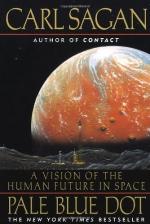
|
| Name: _________________________ | Period: ___________________ |
This test consists of 15 multiple choice questions and 5 short answer questions.
Multiple Choice Questions
1. What type of government is Sagan most opposed to?
(a) Theocracy.
(b) Socialism.
(c) Plutocracy.
(d) Fascism.
2. According to the plans Sagan discussed, how would nuclear weapons typically be used to stop an asteroid from colliding with the Earth?
(a) By splitting it in two.
(b) By destroying it completely.
(c) By reversing its orbit.
(d) By pushing it off-course.
3. What is an astronomical unit?
(a) The distance that light travels in one minute.
(b) The mean distance between stars.
(c) The radius of the solar system.
(d) The distance from the sun to the Earth.
4. What moon was found to have volcanoes?
(a) Europa.
(b) Persephone.
(c) Io.
(d) Terpsichore.
5. Where was NASA's first SETI facility located?
(a) The Mojave desert.
(b) The Nevada salt flats.
(c) The Appalachian mountain range.
(d) The Sierra Nevada mountain range.
6. About how large a percentage of the mass of the total universe does dark matter make up?
(a) Thirty percent.
(b) Five percent.
(c) Sixty percent.
(d) Ninety percent.
7. When did the belief that Venus was a "sister planet" to Earth become dispelled?
(a) The mid nineteenth century.
(b) The late nineteenth century.
(c) The early twentieth century.
(d) The mid twentieth century.
8. The primary discipline that Sagan argues nations benefit from by investing in space exploration is called which of the following?
(a) Interstellar surveying.
(b) Planetary science.
(c) Gestalt geosurveying.
(d) Atmospheric metrics.
9. Which of the following planets is NOT known to have a ring system?
(a) Uranus.
(b) Venus.
(c) Jupiter.
(d) Saturn.
10. CFCs are chemicals that is primarily hazardous to the environment in what area?
(a) The lithosphere.
(b) The biosphere.
(c) The stratosphere.
(d) The ozone-layer.
11. According to Sagan, how profitable is it for a nation to invest in space exploration?
(a) It has great benefits in a limited scope.
(b) It is not related to a nation's welfare.
(c) It is highly profitable.
(d) It has high costs.
12. Sagan estimates that intelligent life might arise on average in one out of how many stars?
(a) One million.
(b) One trillion.
(c) One billion.
(d) Ten thousand.
13. Which of the following characteristics of Venus is LEAST similar to Earth's?
(a) Size.
(b) Orbit.
(c) Gravitation.
(d) Mass.
14. What element does Sagan say motivated the space programs of the 60s and 70s?
(a) Scientific endeavor.
(b) Nationalism.
(c) Curiosity.
(d) Brinksmanship.
15. How well does Sagan say his typical audience handles the practical details of a Mars mission?
(a) They are well-connected and able to deal with the details.
(b) They are uninterested in the details.
(c) They are meticulous thinkers on the subject.
(d) They are hopelessly incapable of dealing with them.
Short Answer Questions
1. What is the shape of the galaxy closest to the Milky Way?
2. Which of the following is one of the moons of Mars?
3. What planet in the solar system obviously suffers from a severe greenhouse gas effect?
4. What type of missions does Sagan recommend in order to prepare to deal with Earth-bound asteroids?
5. Mars apparently once had what resource?
|
This section contains 472 words (approx. 2 pages at 300 words per page) |

|




